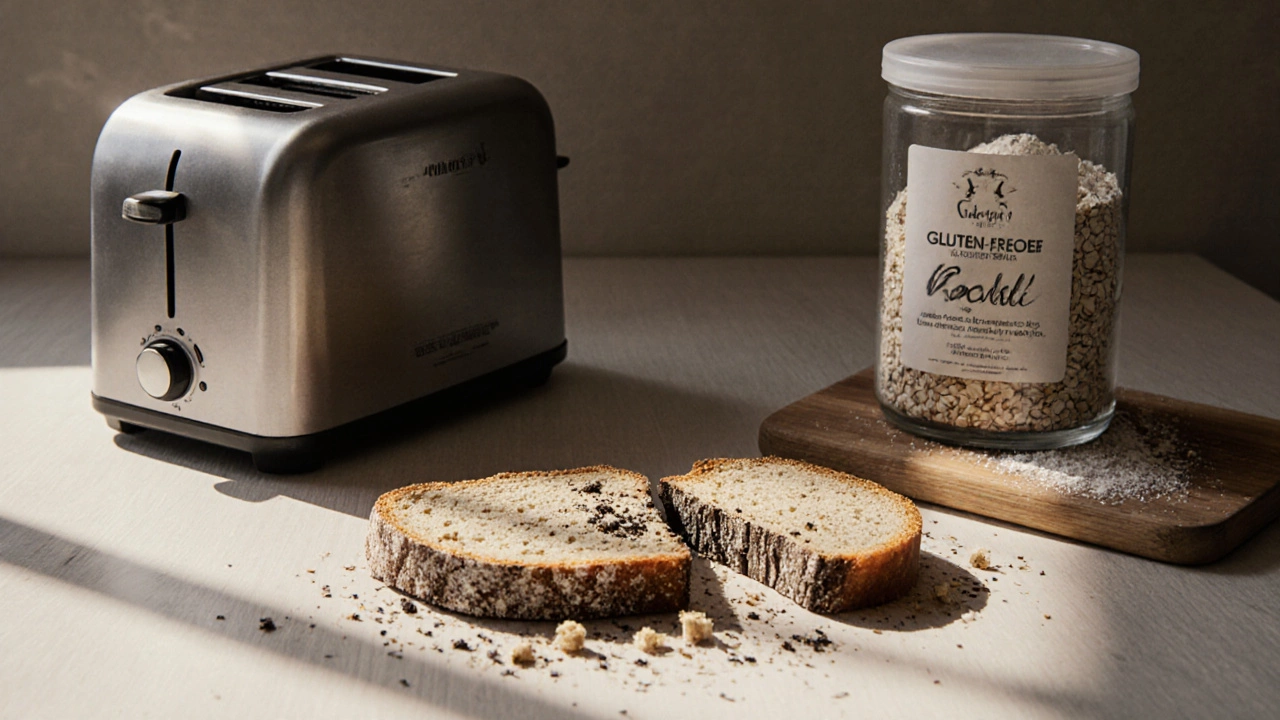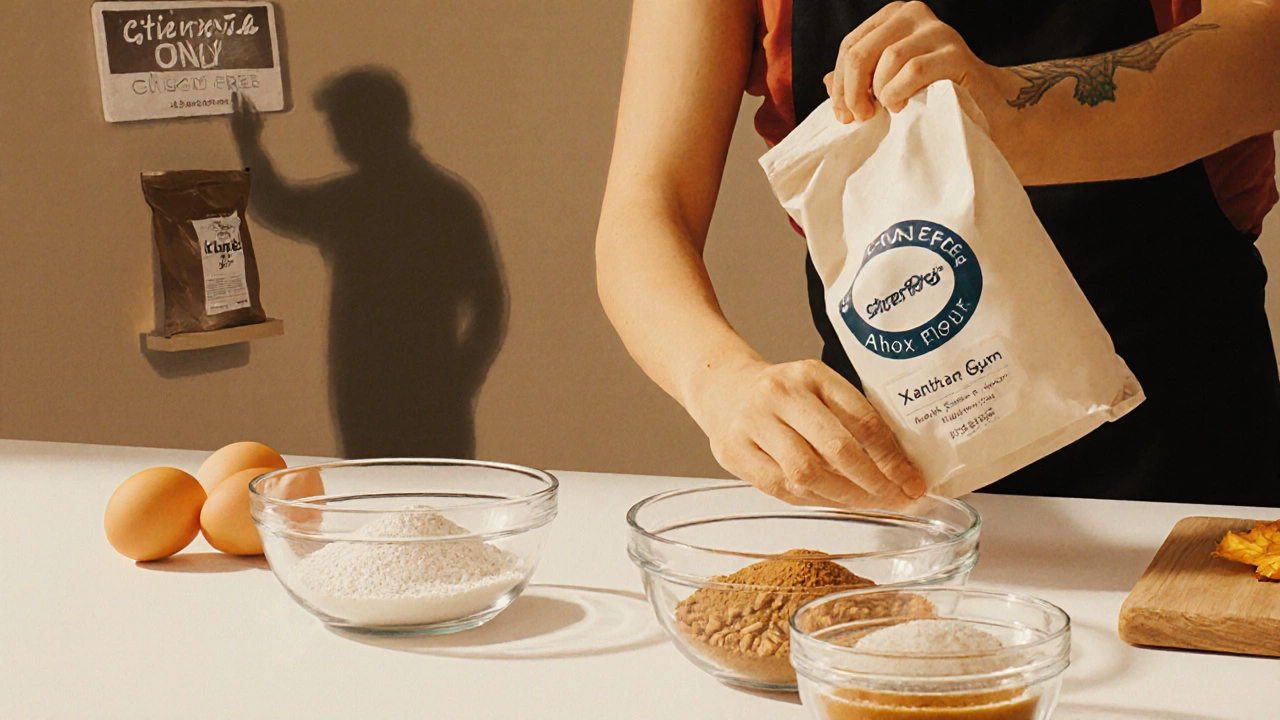
Gluten-Free Food Checker
Check if Your Food is Gluten-Free
Enter a food item to see if it's safe for gluten intolerance. This tool identifies hidden gluten sources and cross-contamination risks.
This food is generally safe
No gluten sources found in this food item.
If you have gluten intolerance, eating the wrong thing can turn a simple meal into a painful day-or worse. It’s not just about bread and pasta. Some of the sneakiest sources of gluten hide in plain sight, even in foods you’d never suspect. And if you’re trying to bake gluten-free cakes or enjoy treats without triggering symptoms, knowing what to avoid is just as important as knowing what’s safe.
Worst Foods for Gluten Intolerance
Gluten is a protein found in wheat, barley, and rye. Even tiny amounts-under 20 parts per million-can cause damage in people with celiac disease or severe gluten sensitivity. The biggest problem? Gluten doesn’t always show up where you expect it.
Here are the top offenders:
- Regular bread, rolls, and bagels - These are the most obvious, but still the most common cause of accidental exposure. Many people think switching to gluten-free bread is enough, but if they keep buying regular bread for others in the house, cross-contamination happens fast.
- Traditional pasta and noodles - Even gluten-free pasta can be contaminated if it’s cooked in the same pot or drained in the same colander as regular pasta. Always use separate tools.
- Soy sauce and teriyaki sauce - Most traditional soy sauce is made with wheat. Tamari is a safer alternative, but check the label. Some brands still add wheat even if they call it "gluten-free."
- Processed meats like sausages, deli meats, and meatballs - Fillers, binders, and flavorings often contain wheat starch or modified food starch derived from wheat. Always read the ingredient list. If it says "starch" without specifying the source, assume it’s wheat unless proven otherwise.
- Beer and malt beverages - Most beer is brewed from barley. Even "gluten-removed" beer isn’t safe for everyone with celiac disease. Stick to certified gluten-free beer made from sorghum, rice, or buckwheat.
- Granola and energy bars - Many are made with oats that aren’t certified gluten-free. Oats themselves don’t contain gluten, but they’re almost always processed in facilities that handle wheat. Look for "certified gluten-free oats" on the label.
- Imitation crab meat - This is a hidden trap. It’s made from surimi (processed fish) mixed with wheat-based fillers. Always avoid unless it’s labeled gluten-free.
- Seasoning mixes and bouillon cubes - Spice blends often include wheat flour as an anti-caking agent. Even plain salt can be contaminated if it’s stored in the same bin as wheat-based seasonings.
- French fries from restaurants - If they’re fried in the same oil as breaded chicken or onion rings, they’re contaminated. Even if they look plain, the oil tells a different story.
- Gluten-free baked goods made in shared kitchens - This one trips up a lot of people. Just because a cake says "gluten-free" doesn’t mean it’s safe. If it was baked in a kitchen that also makes regular cakes, flour dust can settle everywhere. Cross-contamination isn’t just about ingredients-it’s about environment.
Why Cross-Contamination Is the Silent Killer
Many people think they’re doing everything right-eating only labeled gluten-free foods, avoiding wheat-but still get sick. The culprit? Cross-contamination.
Think about your kitchen. If you use the same toaster for gluten-free bread and regular bread, crumbs from the regular bread end up in your gluten-free slice. Same with wooden spoons, cutting boards, or colanders. Gluten is sticky. It clings to surfaces and doesn’t wash off easily.
A 2023 study in the Journal of Pediatric Gastroenterology and Nutrition found that 32% of people with celiac disease who followed a strict gluten-free diet still had ongoing symptoms. In most cases, it wasn’t because they were eating gluten intentionally-it was because of hidden cross-contamination in their own homes.
That’s why baking gluten-free cakes at home is one of the safest choices. But even then, you need to clean everything before you start. Wipe down counters, use fresh bowls and utensils, and store gluten-free flour in a sealed container away from wheat flour.
Gluten-Free Cake Myths That Can Hurt You
If you’re baking gluten-free cakes, you’ve probably heard these myths:
- "All oats are gluten-free." - False. Unless they’re certified gluten-free, oats are likely contaminated. Even brands that claim to be pure can’t guarantee it without third-party testing.
- "If it doesn’t taste like wheat, it’s safe." - Gluten doesn’t change the flavor. You can’t taste or smell it. A cake can be perfectly sweet and fluffy but still contain wheat flour.
- "Gluten-free means healthier." - Not true. Many gluten-free cakes are loaded with sugar, refined starches, and unhealthy fats to mimic the texture of wheat-based cakes. They’re not automatically nutritious.
The only way to know if a cake is safe is to check every ingredient. Even vanilla extract can contain gluten if it’s made with grain alcohol. Stick to brands that clearly state "gluten-free" and avoid anything vague.

What to Look for on Labels
Not all "gluten-free" labels are equal. In the UK and EU, products labeled "gluten-free" must contain less than 20 parts per million (ppm) of gluten. That’s the international standard. But some products say "no gluten ingredients"-that’s not the same thing.
Here’s what to scan for:
- "Gluten-free" certification logo - Look for the Crossed Grain symbol (used in the EU) or the GFCO seal (in the US). These mean third-party testing was done.
- Ingredient list - Watch for: wheat, barley, rye, malt, brewer’s yeast, hydrolyzed wheat protein, modified food starch (unless specified as corn or potato), and dextrin (if source isn’t listed).
- "Made in a facility that also processes wheat" - This is a warning. It doesn’t mean the product contains gluten, but it raises risk. If you’re highly sensitive, avoid these unless the brand has strict cleaning protocols.
Safe Alternatives for Baking Gluten-Free Cakes
When you’re baking gluten-free cakes, you don’t need to sacrifice taste or texture. Here are the best flours and binders to use:
- Rice flour - Mild flavor, works well in blends. Brown rice flour adds more fiber.
- Almond flour - Nutty, moist, and high in protein. Great for dense cakes.
- Cassava flour - Neutral taste, similar texture to wheat flour. Works well as a 1:1 substitute in many recipes.
- Gluten-free oat flour - Only use certified gluten-free oats. Adds chewiness and fiber.
- Tapioca starch - Adds chew and helps bind. Use with other flours.
- Xanthan gum or guar gum - These replace the elasticity gluten provides. Most gluten-free flour blends include them, but if you’re mixing your own, add 1/4 to 1/2 teaspoon per cup of flour.
Many commercial gluten-free cake mixes now include these blends. But homemade gives you full control. Try a simple recipe: almond flour, eggs, maple syrup, baking powder, and vanilla. Bake at 350°F for 25-30 minutes. No need for fancy ingredients.

When to See a Doctor
If you think you have gluten intolerance but haven’t been tested, don’t self-diagnose. Symptoms like bloating, fatigue, brain fog, or skin rashes can also point to other conditions-like IBS, dairy intolerance, or small intestinal bacterial overgrowth (SIBO).
Testing for celiac disease requires you to be eating gluten. If you’ve already gone gluten-free, the test won’t work. Talk to your GP about a blood test and possibly an endoscopy before making big dietary changes.
For non-celiac gluten sensitivity, there’s no official test. But if your symptoms improve on a strict gluten-free diet and return when you eat gluten, that’s strong evidence.
Final Tips for Living Gluten-Free
- Keep a gluten-free kitchen kit: separate toaster, cutting board, utensils, and storage containers.
- Always carry gluten-free snacks when you’re out. Hunger leads to risky choices.
- When dining out, call ahead. Ask if they have a dedicated gluten-free prep area.
- Join a local gluten-free support group. In Bristol, the Gluten-Free Society meets monthly. Real people share real tips.
- Don’t feel guilty about being strict. Your health isn’t optional.
Gluten intolerance isn’t a trend. It’s a medical reality for hundreds of thousands in the UK. The worst foods aren’t always the ones you expect. But with clear labels, careful prep, and smart choices-especially when baking your own cakes-you can eat safely and still enjoy delicious food.
Can gluten-free cakes still contain gluten?
Yes, if they’re made in a kitchen that also handles wheat. Cross-contamination happens through shared tools, surfaces, or even airborne flour. Always check if the cake was made in a dedicated gluten-free facility or if the recipe uses certified gluten-free ingredients.
Are oats safe for gluten intolerance?
Only if they’re labeled "certified gluten-free." Regular oats are contaminated with wheat during farming or processing. Even small amounts can trigger symptoms in sensitive people.
Is soy sauce gluten-free?
Most traditional soy sauce contains wheat. Look for tamari labeled "gluten-free" or coconut aminos as a substitute. Always read the ingredient list-some brands add wheat even if they claim to be gluten-free.
Can I eat gluten-free cake if I have celiac disease?
Yes, but only if it’s made with certified gluten-free ingredients and prepared in a gluten-free environment. Store-bought cakes from shared bakeries carry risk. Homemade cakes using verified ingredients are safest.
What’s the difference between gluten-free and no gluten ingredients?
"No gluten ingredients" means the product doesn’t include gluten-containing items-but it doesn’t guarantee no cross-contamination. "Gluten-free" means the product was tested and contains less than 20 ppm of gluten. Always choose the certified label.